Tunable Electromagnetically Induced Transparent Window of Terahertz Metamaterials and Its Sensing Performance
Abstract
:1. Introduction
2. Design and Simulation
3. Results and Discussion
3.1. Passive Modulation of Metamaterial EIT-like Window
3.2. Active Modulation of Metamaterial EIT-like Window
3.3. Refractive Index Sensing Characteristics of Metamaterial
4. Conclusions
Author Contributions
Funding
Institutional Review Board Statement
Informed Consent Statement
Data Availability Statement
Acknowledgments
Conflicts of Interest
References
- Harris, S.E. Electromagnetically induced transparency. Phys. Today 1997, 50, 36–42. [Google Scholar] [CrossRef]
- Hau, L.V.; Harris, S.E.; Dutton, Z.; Behroozi, C.H. Light speed reduction to 17 metres per second in an ultracold atomic gas. Nature 1999, 397, 594–598. [Google Scholar] [CrossRef]
- Sultana, J.; Islam, M.S.; Ahmed, K.; Dinovitser, A.; Ng, B.W.H.; Abbott, D. Terahertz detection of alcohol using a photonic crystal fiber sensor. Appl. Opt. 2018, 57, 2426–2433. [Google Scholar] [CrossRef] [PubMed]
- Zhang, L.; Tassin, P.; Koschny, T.; Kurter, C.; Anlage, S.M.; Soukoulis, C.M. Large group delay in a microwave metamaterial analog of electromagnetically induced transparency. Appl. Phys. Lett. 2010, 97, 241904. [Google Scholar] [CrossRef] [Green Version]
- Yin, X.G.; Feng, T.H.; Yip, S.; Liang, Z.X.; Hui, A.; Ho, J.C.; Li, J.S. Tailoring electromagnetically induced transparency for terahertz metamaterials: From diatomic to triatomic structural molecules. Appl. Phys. Lett. 2013, 103, 021115. [Google Scholar] [CrossRef] [Green Version]
- Liu, M.; Tian, Z.; Zhang, X.Q.; Gu, J.Q.; Ouyang, C.M.; Han, J.G.; Zhang, W.L. Tailoring the plasmon-induced transparency resonances in terahertz metamaterials. Opt. Express 2017, 25, 19844–19855. [Google Scholar] [CrossRef] [PubMed]
- Singh, R.; Rockstuhl, C.; Menzel, C.; Meyrath, T.P.; He, M.X.; Giessen, H.; Lederer, F.; Zhang, W.L. Spiral-type terahertz antennas and the manifestation of the Mushiake principle. Opt. Express 2009, 17, 9971–9980. [Google Scholar] [CrossRef] [Green Version]
- Schurig, D.; Mock, J.J.; Justice, B.J.; Cummer, S.A.; Pendry, J.B.; Starr, A.F.; Smith, D.R. Metamaterial electromagnetic cloak at microwave frequencies. Science 2006, 314, 977–980. [Google Scholar] [CrossRef] [Green Version]
- Gu, J.Q.; Han, J.G.; Lu, X.C.; Singh, R.; Tian, Z.; Xing, Q.R.; Zhang, W.L. A close-ring pair terahertz metamaterial resonating at normal incidence. Opt. Express 2009, 17, 20307–20312. [Google Scholar] [CrossRef] [Green Version]
- Cao, P.F.; Li, C.C.; Li, Y.; Wu, Y.Y.; Chen, X.Y.; Wu, T.; Zhang, X.Q.; Yuan, M.R.; Wang, Z.L. Electromagnetically Induced Transparency-Like Approach Based on Terahertz Metamaterials for Ultrasensitive Refractive Index Sensors. IEEE Sens. J. 2022, 22, 2110–2118. [Google Scholar] [CrossRef]
- Wang, W.; Yan, F.P.; Tan, S.Y.; Zhou, H.; Hou, Y.F. Ultrasensitive terahertz metamaterial sensor based on vertical split ring resonators. Photonics Res. 2017, 5, 571–577. [Google Scholar] [CrossRef]
- Papasimakis, N.; Fu, Y.H.; Fedotov, V.A.; Prosvirnin, S.L.; Tsai, D.P.; Zheludev, N.I. Metamaterial with polarization and direction insensitive resonant transmission response mimicking electromagnetically induced transparency. Appl. Phys. Lett. 2009, 94, 211902. [Google Scholar] [CrossRef] [Green Version]
- Papasimakis, N.; Fedotov, V.A.; Zheludev, N.I.; Prosvirnin, S.L. Metamaterial Analog of Electromagnetically Induced Transparency. Phys. Rev. Lett. 2008, 101, 253903. [Google Scholar] [CrossRef] [Green Version]
- Liu, N.; Weiss, T.; Mesch, M.; Langguth, L.; Eigenthaler, U.; Hirscher, M.; Sonnichsen, C.; Giessen, H. Planar Metamaterial Analogue of Electromagnetically Induced Transparency for Plasmonic Sensing. Nano Lett. 2010, 10, 1103–1107. [Google Scholar] [CrossRef] [PubMed]
- Zhang, S.; Genov, D.A.; Wang, Y.; Liu, M.; Zhang, X. Plasmon-induced transparency in metamaterials. Phys. Rev. Lett. 2008, 101, 047401. [Google Scholar] [CrossRef] [Green Version]
- Zhu, Z.H.; Yang, X.; Gu, J.Q.; Jiang, J.; Yue, W.S.; Tian, Z.; Tonouchi, M.; Han, J.G.; Zhang, W.L. Broadband plasmon induced transparency in terahertz metamaterials. Nanotechnology 2013, 24, 214003. [Google Scholar] [CrossRef] [PubMed]
- Pan, W.; Yan, Y.J.; Ma, Y.; Shen, D.J. A terahertz metamaterial based on electromagnetically induced transparency effect and its sensing performance. Opt. Commun. 2019, 431, 115–119. [Google Scholar] [CrossRef]
- Xia, S.X.; Zhai, X.; Wang, L.L.; Sun, B.; Liu, J.Q.; Wen, S.C. Dynamically tunable plasmonically induced transparency in sinusoidally curved and planar graphene layers. Opt. Express 2016, 24, 17886–17899. [Google Scholar] [CrossRef]
- Shu, C.; Chen, Q.G.; Mei, J.S.; Yin, J.H. Analogue of tunable electromagnetically induced transparency in terahertz metal-graphene metamaterial. Mater. Res. Express 2019, 6, 055808. [Google Scholar] [CrossRef]
- Patel, S.K.; Surve, J.; Jadeja, R.; Katkar, V.; Parmar, J.; Ahmed, K. Ultra-Wideband, Polarization-Independent, Wide-Angle Multilayer Swastika-Shaped Metamaterial Solar Energy Absorber with Absorption Prediction using Machine Learning. Adv. Theor. Simul. 2022, 2100604. [Google Scholar] [CrossRef]
- Shen, S.M.; Liu, Y.L.; Liu, W.Q.; Tan, Q.L.; Xiong, J.J.; Zhang, W.D. Tunable electromagnetically induced reflection with a high Q factor in complementary Dirac semimetal metamaterials. Mater. Res. Express 2018, 5, 125804. [Google Scholar] [CrossRef]
- Liu, X.J.; Gu, J.Q.; Singh, R.; Ma, Y.F.; Zhu, J.; Tian, Z.; He, M.X.; Han, J.G.; Zhang, W.L. Electromagnetically induced transparency in terahertz plasmonic metamaterials via dual excitation pathways of the dark mode. Appl. Phys. Lett. 2012, 100, 131101. [Google Scholar]
- Li, Z.Y.; Ma, Y.F.; Huang, R.; Singh, R.J.; Gu, J.Q.; Tian, Z.; Han, J.G.; Zhang, W.L. Manipulating the plasmon-induced transparency in terahertz metamaterials. Opt. Express 2011, 19, 8912–8919. [Google Scholar] [CrossRef] [PubMed] [Green Version]
- Jiang, J.X.; Cui, J.F.; Fang, R.Q.; Wu, F.M.; Yang, Y.Q. Tunable Electromagnetically Induced Transparency in Asymmetric Graphene-Based Metamaterial at Terahertz Region. Integr. Ferroelectr. 2020, 212, 1–8. [Google Scholar] [CrossRef]
- Chiam, S.Y.; Singh, R.; Rockstuhl, C.; Lederer, F.; Zhang, W.L.; Bettiol, A.A. Analogue of electromagnetically induced transparency in a terahertz metamaterial. Phys. Rev. B 2009, 80, 153103. [Google Scholar] [CrossRef] [Green Version]
- Yahiaoui, R.; Burrow, J.A.; Mekonen, S.M.; Sarangan, A.; Mathews, J.; Agha, I.; Searles, T.A. Electromagnetically induced transparency control in terahertz metasurfaces based on bright-bright mode coupling. Phys. Rev. B 2018, 97, 155403. [Google Scholar] [CrossRef] [Green Version]
- Liu, N.; Langguth, L.; Weiss, T.; Kastel, J.; Fleischhauer, M.; Pfau, T.; Giessen, H. Plasmonic analogue of electromagnetically induced transparency at the Drude damping limit. Nat. Mater. 2009, 8, 758–762. [Google Scholar] [CrossRef]
- Yahiaoui, R.; Tan, S.Y.; Cong, L.Q.; Singh, R.; Yan, F.P.; Zhang, W.L. Multispectral terahertz sensing with highly flexible ultrathin metamaterial absorber. J. Appl. Phys. 2015, 118, 083103. [Google Scholar] [CrossRef]
- Singh, R.; Cao, W.; Al-Naib, I.; Cong, L.Q.; Withayachumnankul, W.; Zhang, W.L. Ultrasensitive terahertz sensing with high-Q Fano resonances in metasurfaces. Appl. Phys. Lett. 2014, 105, 171101. [Google Scholar] [CrossRef] [Green Version]
- Rodriguez-Ulibarri, P.; Kuznetsov, S.A.; Beruete, M. Wide angle terahertz sensing with a cross-dipole frequency selective surface. Appl. Phys. Lett. 2016, 108, 111104. [Google Scholar] [CrossRef]

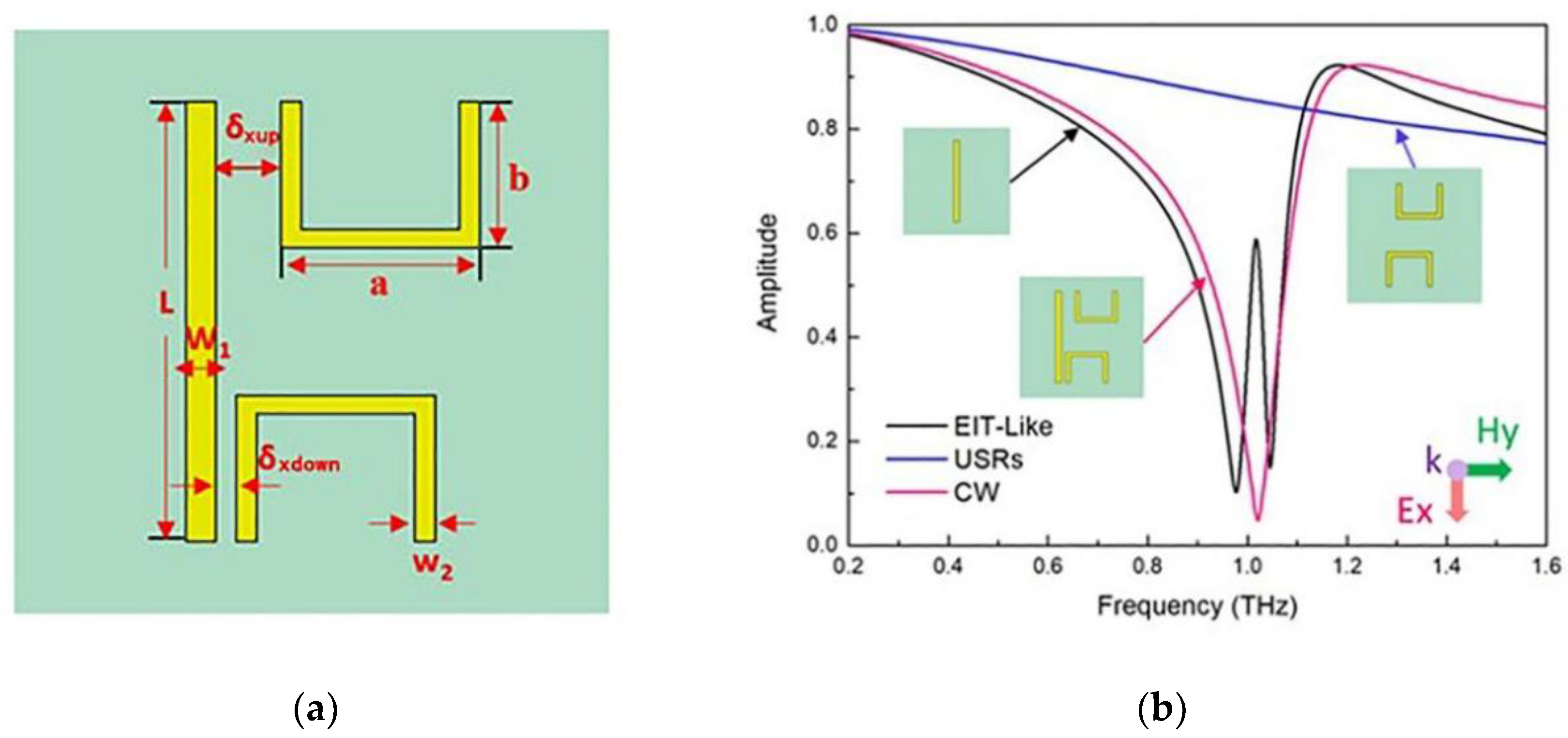


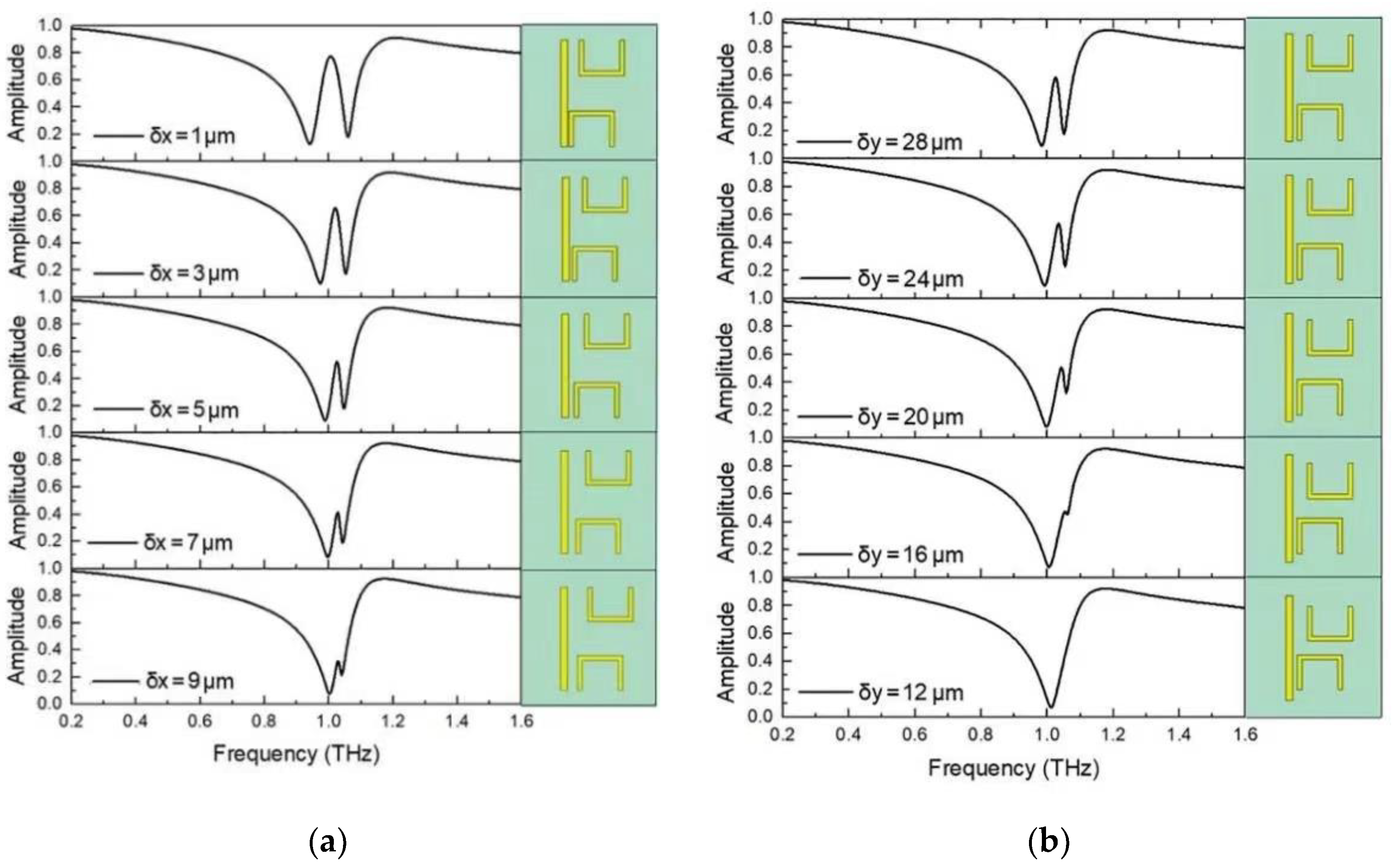
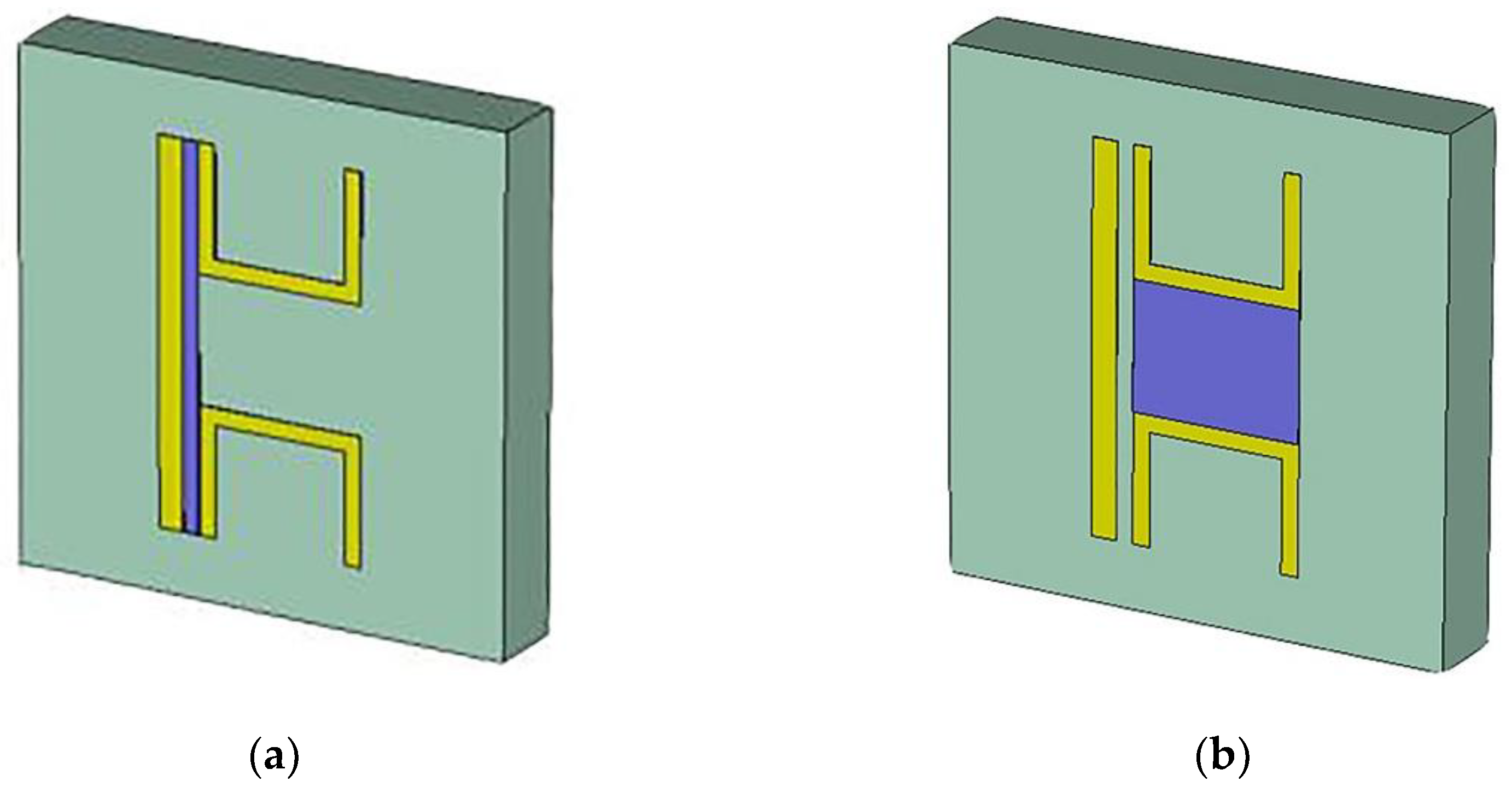
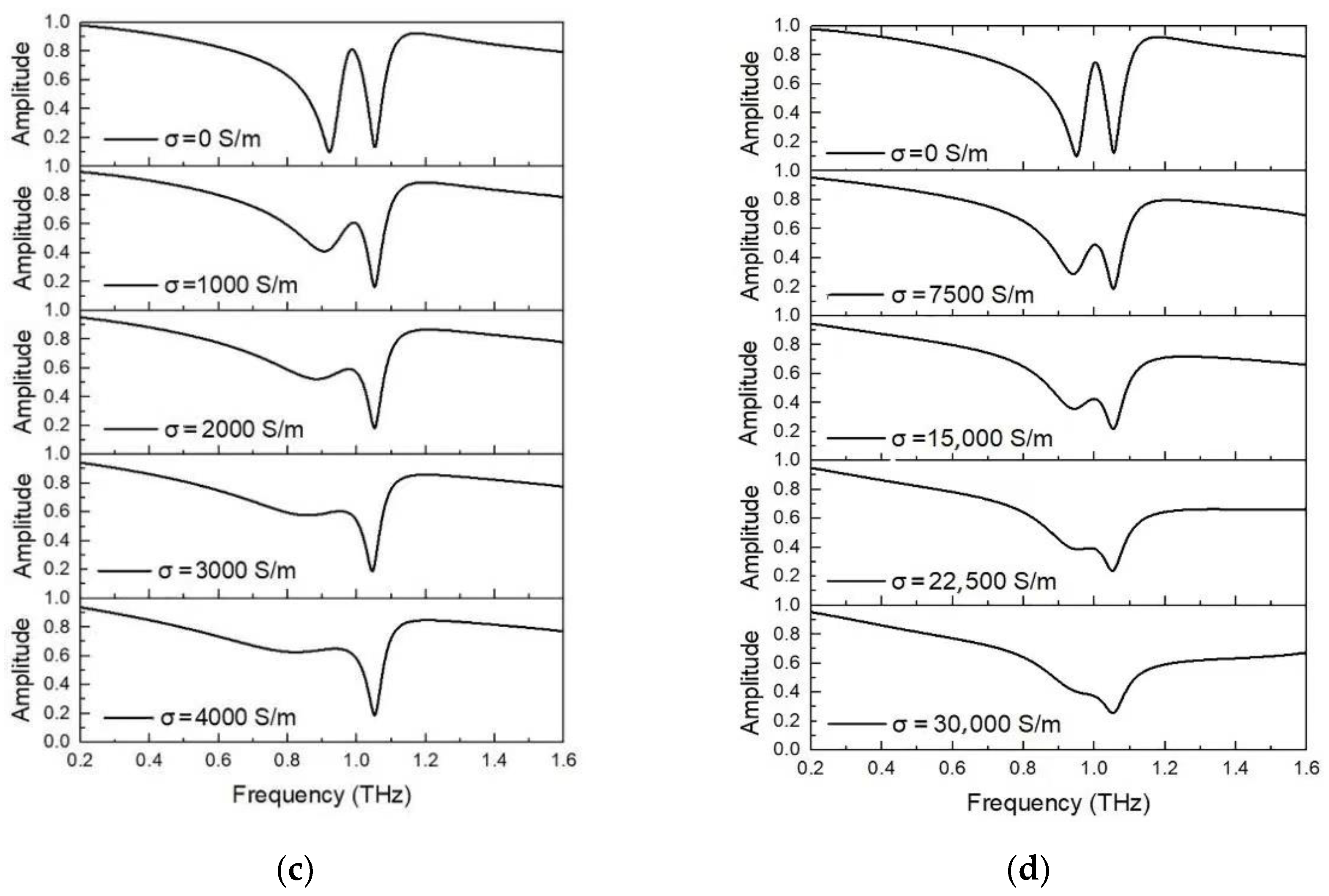
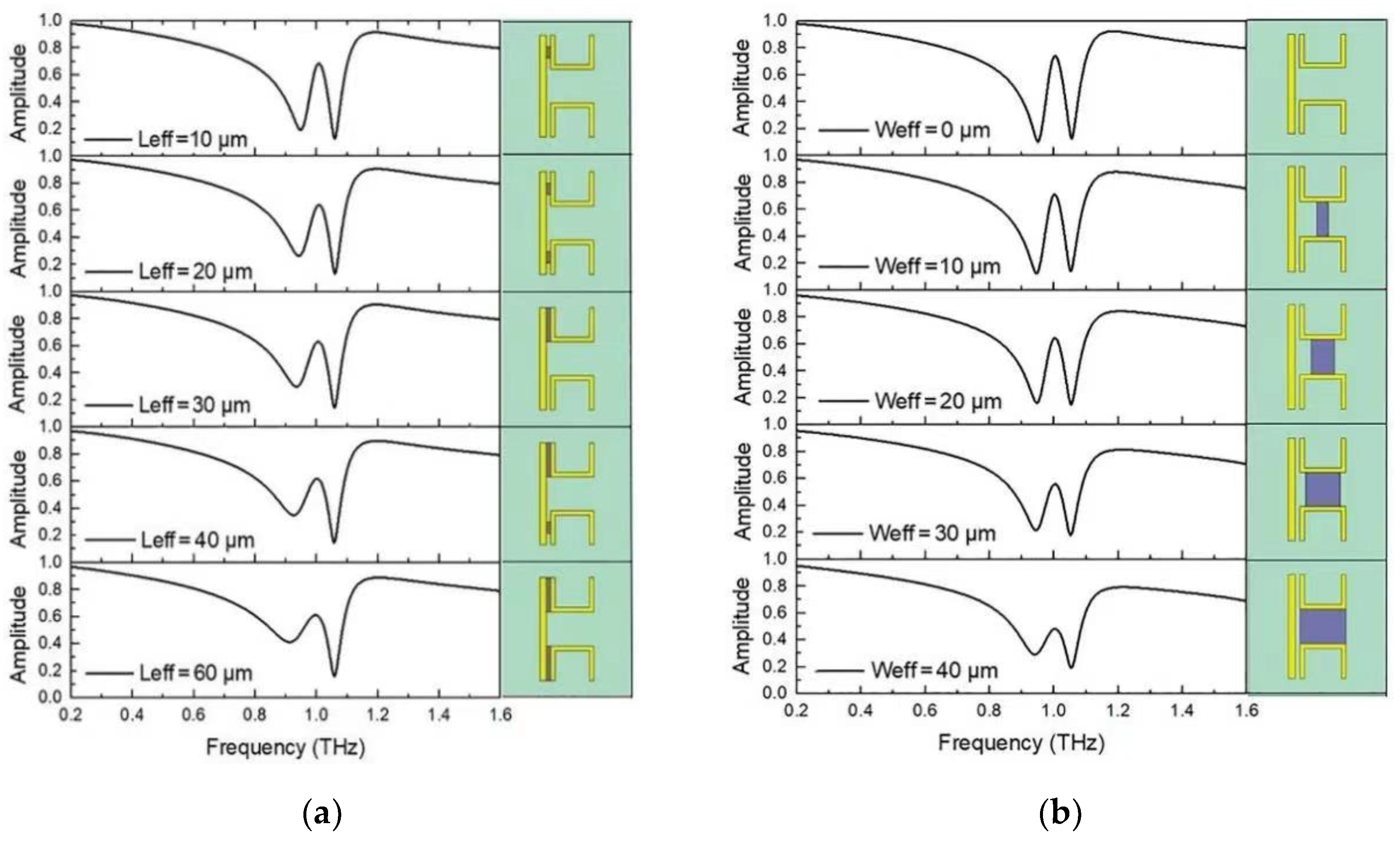

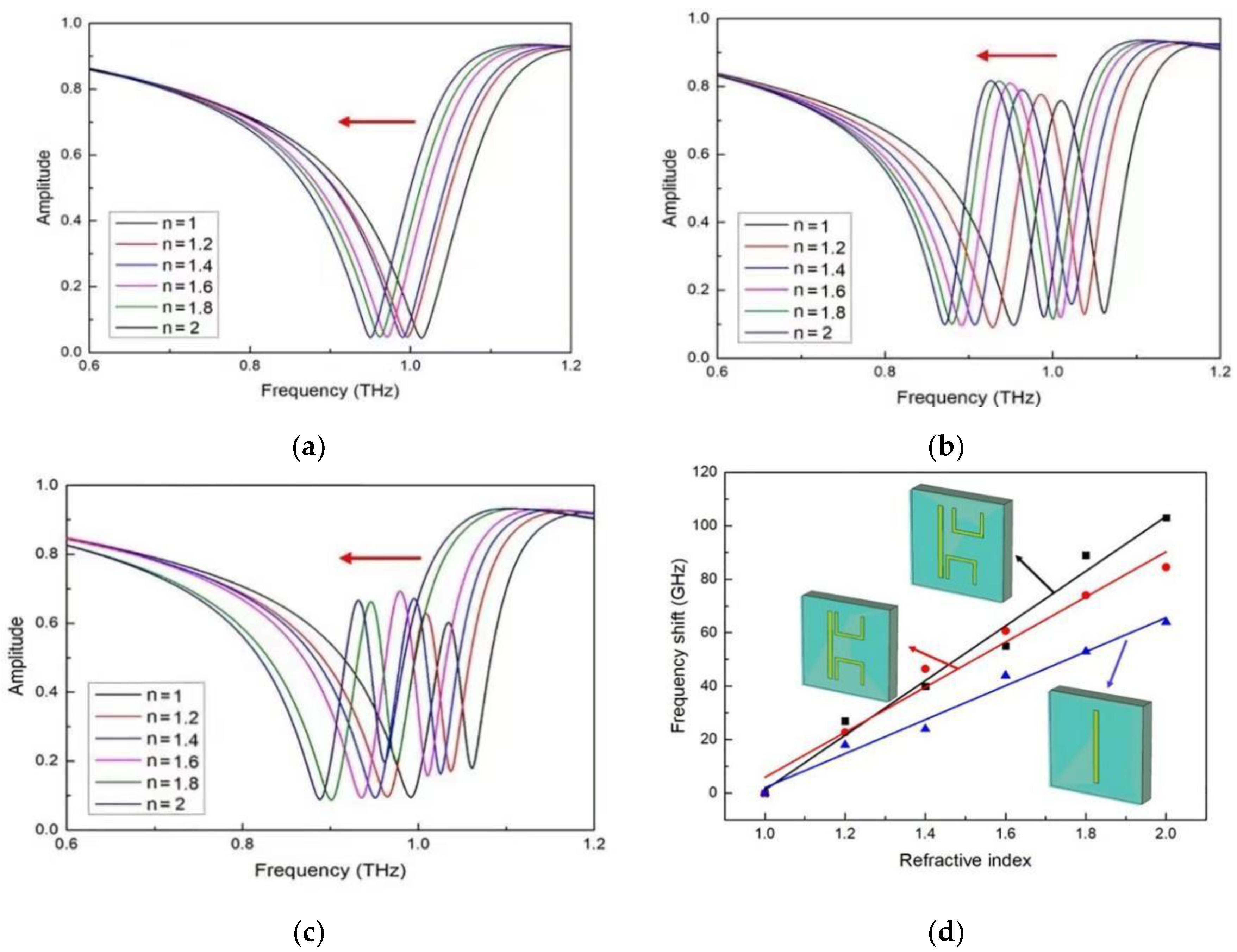
| Structure | Bandwidth | Sensitivity | Q-Factor | FOM |
|---|---|---|---|---|
| (THz) | (GHz/RIU) | |||
| This work (unilateral symmetric) | 0.6–1.2 | 84.4 | 33.67 | 2.8 |
| This work (unilateral asymmetric) | 0.6–1.2 | 102.3 | 51 | 5.115 |
| Ref. [28] | 0.15–0.85 | 54.18 | -- | -- |
| Ref. [10] | 0.6–1.2 | 102 | 20 | 2.99 |
| Ref. [29] | 1.05–1.17 | 49.3 | 65 | -- |
| Ref. [30] | 0.4–1.0 | 180 | 0.22 | -- |
| Ref. [11] | 0.8–1.6 | 163 | 7.036 | 2.67 |
Publisher’s Note: MDPI stays neutral with regard to jurisdictional claims in published maps and institutional affiliations. |
© 2022 by the authors. Licensee MDPI, Basel, Switzerland. This article is an open access article distributed under the terms and conditions of the Creative Commons Attribution (CC BY) license (https://creativecommons.org/licenses/by/4.0/).
Share and Cite
Wu, Z.; An, P.; Ding, M.; Qi, Y.; Zhang, L.; Han, S.; Lian, D.; Chen, C.; Yang, X. Tunable Electromagnetically Induced Transparent Window of Terahertz Metamaterials and Its Sensing Performance. Appl. Sci. 2022, 12, 7057. https://doi.org/10.3390/app12147057
Wu Z, An P, Ding M, Qi Y, Zhang L, Han S, Lian D, Chen C, Yang X. Tunable Electromagnetically Induced Transparent Window of Terahertz Metamaterials and Its Sensing Performance. Applied Sciences. 2022; 12(14):7057. https://doi.org/10.3390/app12147057
Chicago/Turabian StyleWu, Zhenlin, Peiyao An, Menghan Ding, Yanan Qi, Lin Zhang, Shaoshuai Han, Di Lian, Changming Chen, and Xin Yang. 2022. "Tunable Electromagnetically Induced Transparent Window of Terahertz Metamaterials and Its Sensing Performance" Applied Sciences 12, no. 14: 7057. https://doi.org/10.3390/app12147057
APA StyleWu, Z., An, P., Ding, M., Qi, Y., Zhang, L., Han, S., Lian, D., Chen, C., & Yang, X. (2022). Tunable Electromagnetically Induced Transparent Window of Terahertz Metamaterials and Its Sensing Performance. Applied Sciences, 12(14), 7057. https://doi.org/10.3390/app12147057






